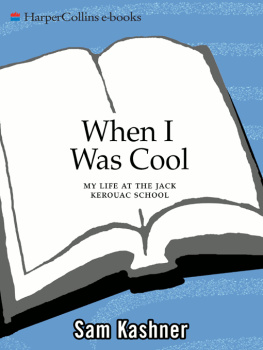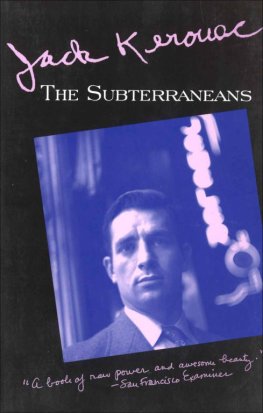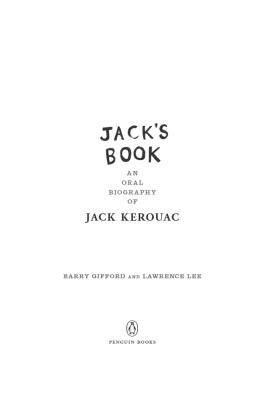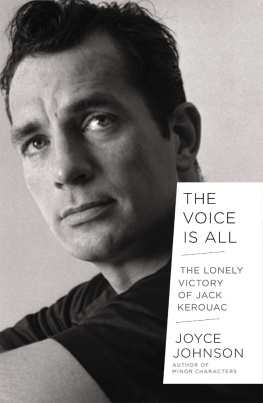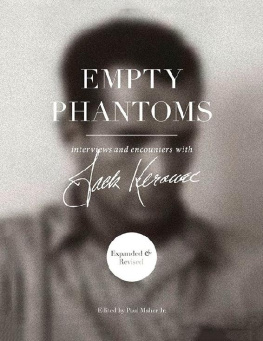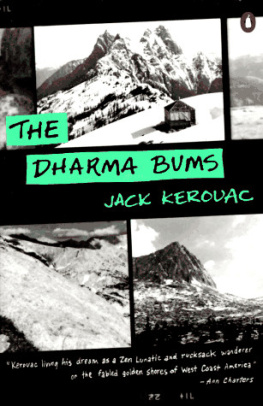Sam Kashner
When I Was Cool
My Life at the Jack Kerouac School
A Memoir

For N.
"The world is full of renunciations and apprenticeships, and this is thine: thou must pass for a fool and a churl for a long season.
R ALPH W ALDO E MERSON , T HE P OET
Caveat Emptor
Please dont read this book if youre looking (as I was in the early 1970s) for a history of the Beat Generation. When I got hooked on Howl and On the Road, when I was ga-ga for The Dharma Bums and Gregory Corsos poem Bomb (which folded out of the book as if dropped from an F-15; and it looked like a bomb, too, the way the words were arranged on the page), there werent many books on the Beats. Now theres a tower of Babel. Ginsberg, Burroughs, Kerouac, Corsotheyve become the Rat Pack of literature. Anne Waldman is their Angie Dickinson.
In truth, there are many wonderful books on the Beats. Ann Charters, an old friend of Ginsbergs who wrote one of the first and still one of the best biographies of Kerouac, is supreme. Theres Gordon Ball, Allens Boswell, who knew Ginsberg as well as anyone and helped put together Allen Verbatim and all the published journals and correspondence; and you should read Barry Miles, Ginsbergs biographer, and Steven Watson, who wrote a wonderful book called The Birth of the Beat Generation. Ed Sanders wrote Tales of Beatnik Glory; he, too, knew them all, as did John Tytell, who was there almost before anyone. Also, Diane di Prima and Hettie Jones, for their remarkable memoirs of the Beat life, as well as Michael Schumachers epic life, Dharma Lion: A Critical Biography of Allen Ginsberg. And then theres Gerald Nicosia, and Kerouacs other fine biographers and chroniclers, such as Tom Clark, John McNally, and of course Barry Gifford. Not to mention Joyce Johnson, whose mighty Minor Characters is a great book about her life with and without Jack Kerouac. These are the historians of the era, and these wonderful books and a few others Ive used as an aide de memoire , and am deeply grateful to the authors.
I wasnt there at the beginning or even the middle. I was there for the ending. Or, maybe, the beginning of the end. I wasnt a beatnik; I wasnt even a hippie. But I wanted to write poetry and have cool friends and thumb my nose at the establishment; at the same time I wanted to make my parents proud of me. How was I going to do all that?
These are letters from camp. Beat camp. My counselors happened to be former Beats: Allen Ginsberg taught me swimming and Swinburne; William Burroughs took us deep into the forest and then told us which one of us was probably an alien; Gregory Corso taught us how to singonly the camp song was an aria from Pagliacci and his philosophy was strictly jail yard: Never rat on a friend.
When I left the south shore of Long Island for my Beat experience at the Jack Kerouac School of Disembodied Poetics in 1976, I didnt know who I was. I just knew what I didnt want to be. After arriving, I was initially afraid of the Beats; I even tried to stay away from them. But they were my teachers, so I couldnt avoid them for long. I had nothing to offer them. I wanted them to make me an artist. I wanted the noble calling of literature. There was nothing I could do but enter the hive.
Some people may think this book is an act of heresy. Maybe it is. Maybe it isnt. Maybe its an answer to Gregorys last phone call to me: Tell me the truth, he barked, without even saying hello. Maybe all you need for heresy is an opportunity. Someone once said that the past is a kind of prison. You dont always get the chance to open a window in jail. This is my chance.
I wanted to be in the picture. I just cant remember where I first saw it: the photograph in front of City Lights Bookstore of Allen Ginsberg, Peter Orlovsky, and Neal Cassady. They had their arms around each other. They looked happy. They looked like friends. They looked like they understood each other. And Allen Ginsberghe looked like me.
In the photograph Allen was thin, he had short dark hair, and he wore glasses. Everyone in the pictureeven Neal Cassady, the tough guy in the white T-shirtseemed to like Allen. The photograph projected a feeling of bonhomie. But I cant remember where I first saw it. It mightve been at Philip Weiners house. He was two years older than I. He was fifteen. The Weiners lived next door, around the corner on Shore Drive in Merrick, a prosperous little town on the south shore of Long Island, about an hour from New York City on the Long Island Rail Road. Our split-level houses were so close that I could see the Weiners bathroom shelf from the window of my fathers downstairs office.
Philips parents were swingers. They went into New York City a lot. Irving Weiner had an office in the garment district. He made childrens pajamas. (That was before we knew pajamas could catch on fire.) He took his clients to the Copacabana. The Weiners had framed photos of themselves sitting with other couples at the Copa, looking very glamorous. My mother was always commenting on Shirley Weiners glorious figure. Every summer she would lie out in the sun on a lawn chair in her backyard in a bikini, smoking a cigarette and sipping a drink. She wore high heels around the house. This was in the late sixties, when the suburbs were supposed to be a safe refuge from the big city.
As soon as I hit puberty, I longed for the big city.
Philips bedroom was in a converted attic. He had a chemistry set. He said he was working on some kind of formula that would make him invisible. (I always looked to see how I could escape from Philips attic if I had to. I didnt want him to make me drink the invisibility potion he was cooking up.) He was also the first guy I knew who listened to Bob Dylan records. He showed me one. It was Bringing It All Back Home. Philip pointed out all the interesting things thrown around the room in the picture on the album cover, such as a copy of Sing Out! magazine and a Dave Van Ronk album. I didnt know what they were. We looked at the song titles and the numbers next to them. I wanted to sound like I knew something, so I told Philip that the numbers next to the songs were the time of day each song was recorded. He said that was impossible. He said we should time the songs and then Id see how they were only the length of time of each song.
Philip then asked me if I knew about Allen Ginsberg or if Id ever heard of William Burroughs. He said that Burroughs, best known for his mind-boggled, heroin-laced novel Naked Lunch, had gone into the jungle to look for a rare hallucinogenic drug called yag. Philip said we should go and search for this drug near Cammans Pond in Merrick. We did, but we didnt find it. We found only a few crushed beer cans and a used condom.
Back then, Bob Dylans voice scared me a little, but the picture of Allen Ginsberg meant something to me. Philip had cut out of the Village Voice another picture of Allen wearing a scarf and glasses, a long, unkempt beard, and an Uncle Sam hat. I didnt know why, but I just wanted to take that picture home with me. When Philip started talking about the Beat Generation, I suddenly felt the enthusiasm of the liberated. Something new had crossed my path.
I soon realized I had much to learn. Philip took out one of Allens City Lights books and read one of the poems to me. I think it was about running into Walt Whitman at the supermarket. At the time (seventh grade), I didnt know who Walt Whitman was. I thought it mightve had something to do with foodmaybe the Whitman Sampler box of candies. It didnt matter. A new world with its own planets, its own creation, its own myths had just come swimming into my brain. Philips stories about Burroughs and Ginsberg and their friend Jack Kerouac were like tombstones kicked over in the dark. It was joyfulness in the face of junior high school desk death.

